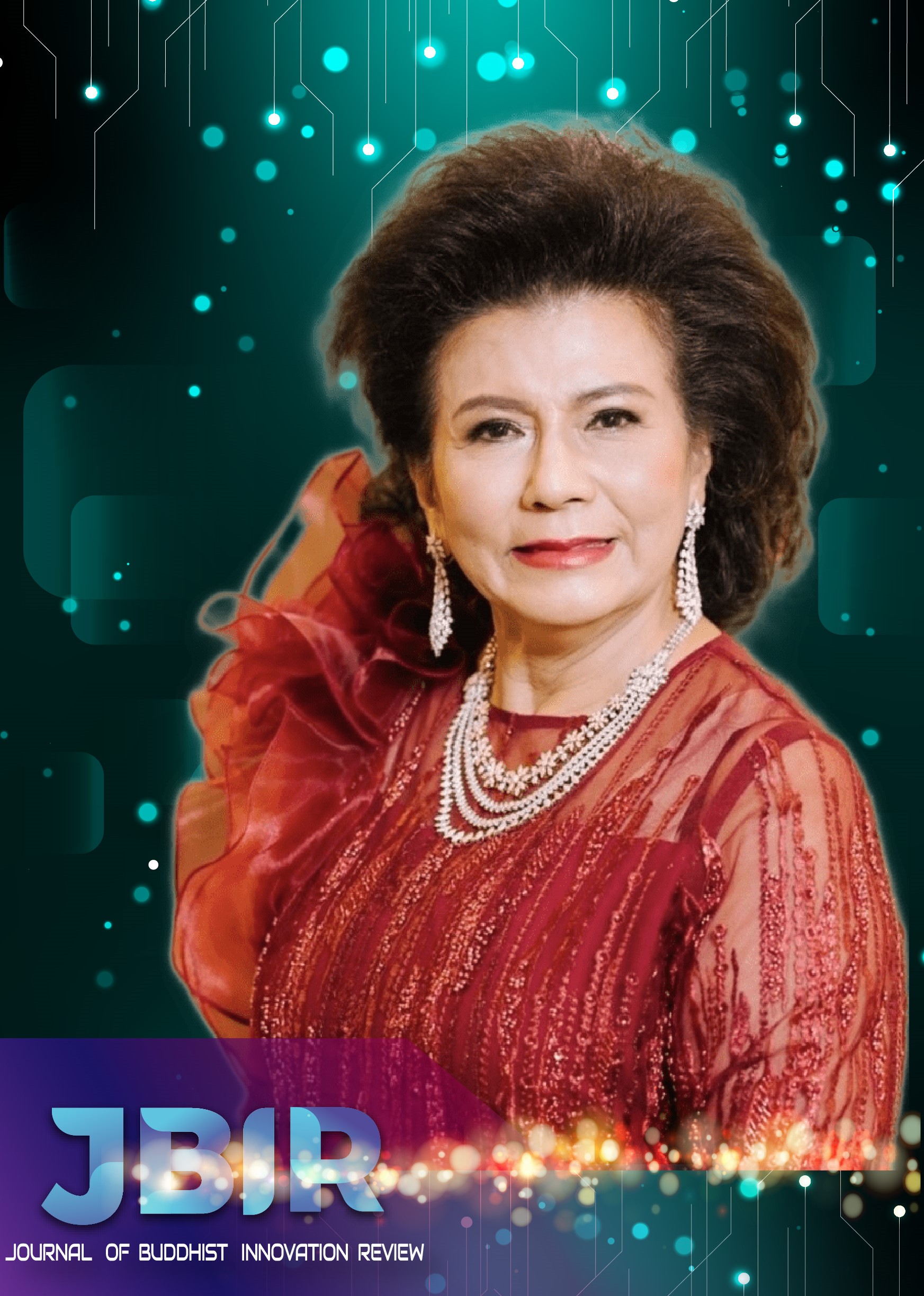Integration of Buddhism Principle and Solid Wastes Processing by Circular Economy Towards Resulted Base Management: Case Study of Buddhism Temples
Main Article Content
Abstract
The presentation herein was the qualitative study focused on depth interview integrated with some quantitative study and content analysis. Buddhism temples as case studies included Wat (Temple) Chakdang, Wat Suankaew, Wat Yanvesakawan, Wat Pa Udomsuk, Suankaew Foundation Branch at Kabinburi, and Suankaew Foundation Branch at Burirum. Depth interview had been individually undertaken through the abbots, monks, monk assistants (man or woman), workers in the temple. The main concept of management of all temples is an integration of Buddhism principle for the green area as spiritual wellness community and solid waste processing by CE, but different approach. Wat Chakdang and Wat Yanvesakawan, as well as Wat Pa Udomsuk had developed green area by only trees plantation, but Wat Suankaew and Foundation Branches had developed green area by an integrated agriculture. All temples and Foundation Branches except Wat Yanvesakawan had carried out solid wastes processing by CE. Wat Chakdang had emphasized the recycle processing particularly plastic bottles recycled to fiber to proceed for yellow robe for monk, blanket, T-shirt etc. The CE approaches thus were mainly reduction together with recycle, and some repair and refurbish. While Wat Suankaew had used donated items for solid wastes processing through separation and selling to the old thing retailing shops by bidding. The approach was mainly reduction together with repair, and some recycle. The significant factor influencing the RBM was leader and leadership of the abbot. Such leader and leadership had enticed the people motivation towards cooperation. In addition, integration management, innovation of solid wastes processing by CE, cooperation, networking, and policy/plan to action were all factors influencing the RBM on the sustainable development concept.
Article Details

This work is licensed under a Creative Commons Attribution-NonCommercial-NoDerivatives 4.0 International License.
เรื่องลิขสิทธิ์/เป็นความคิดเห็นของผู้เขียน
References
หนังสือ
กรมควบคุมมลพิษ. (2547). คู่มือปฏิบัติการนำขยะมูลฝอยมาใช้ให้เกิดประโยชน์สำหรับวัดในพระพุทธศาสนา.กรุงเทพฯ: โรงพิมพ์คุรุสภาลาดพร้าว.
กรมควบคุมมลพิษ. (2566). รายงานสถานการณ์มลพิษของประเทศไทย ปี 2565. กรุงเทพฯ. บริษัท เอพี คอนเน็กซ์ จำกัด
จิรัตน์ เขียวชอุ่ม และคณะ. (2563). รายงานการวิจัยการลดปริมาณขยะบนเกาะหลีเป๊ะอย่างยั่งยืน โดยกระบวนการมีส่วนร่วม. กรุงเทพมหานคร: สำนักงานการวิจัยแห่งชาติ (วช.)
จินตนา สุจจานันท์. (2549). การศึกษาและการพัฒนาชุมชน. กรุงเทพฯ: โอ.เอส.พริ้นติ้งเฮ้าส์
ธเรศ ศรีสถิตย์. (2558). วิศวกรรมการจัดการมูลฝอยชุมชน. กรุงเทพมหานคร: วิศวกรรมสถานแห่งประเทศไทยในพระบรมราชูปถัมภ์
เมตต์ เมตต์การุณ์จิต. (2553). การบริหารจัดการศึกษาแบบมีส่วนร่วม: ประชาชน องค์กรปกครองส่วนท้องถิ่นและราชการ. กรุงเทพมหานคร: บุ๊ค พอยท์
วรเดช จันทรศร. (2540). การนนำนโยบายไปปฏิบัติ. กรุงเทพฯ: กราฟิคฟอร์แมท (ไทยแลนด์)
สื่ออิเล็กทรอนิกส์
ณรงค์กร มโนจันทร์เพ็ญ. (2564). สถานการณ์ขยะโลกกับประเทศที่ผลิตขยะมากที่สุดในโลกขณะนี้. [สืบค้นวันที่ 25 ตุลาคม 2566] จาก https://thestandard.co/garbage-situation/
ณิชชา บูรณสิงห์. (2559). นโยบายประชารัฐ: แนวทางการจัดการขยะในประเทศไทย. [สืบค้นวันที่ 25 ตุลาคม 2566] จาก https://www.parliament.go.th/ewtadmin/ewt/ parliament_ parcy/ewt_dl_link.php?nid=42894
สถาบันวิจัยวิทยาศาสตร์และเทคโนโลยีแห่งประเทศไทย กระทรวงวิทยาศาสตร์และเทคโนโลยี. (2562) .เศรษฐกิจหมุนเวียน...ที่ทุกคนรู้. [สืบค้นวันที่ 25 ตุลาคม 2566] จาก https://www.mhesi.go.th/images/STBookSeries/BS003CircularEconomy.pdf
สำนักงานสถิติแห่งชาติ. (2563). สถิติบุคลากรและศาสนสถานทางศาสนาในประเทศไทย. [สืบค้นวันที่ 4 กุมภาพันธ์ 2565] จาก http://ittdashboard.nso.go.th/preview.php?id_project=56
หนังสือภาษาต่างประเทศ
Daniel Hoornweg and Perinaz Bhada-Tata. (2012). WHAT A WASTE: A Global Review of Solid Waste Management. Washington, DC: World Bank. https://openknowledge.worldbank.org/ handle/10986/17388.
Herzberg, Frederick and others. (1959). The Motivation to work. New York: John Wiley and Son.
McClelland, D. C. (1961). The achieving society. Princeton, NJ: Van Nostrand
Russ Linden, “A Framework for change in the U.S.D.A Forest Service’s,”NEPA Process. For the 21 Century Project (2007) (accessed Nov. 17, 2023)
Straus, David. (2002). How to Make Collaboration Work. San Francisco: BerrettKoehler Publishers.
สัมภาษณ์
พระราชวัชรบัณฑิต (ประนอม ธมฺมาลงฺกาโร). เจ้าอาวาสวัดจากแดง. วันที่สัมภาษณ์ 19 มกราคม 2567.
นางปารณีย์ แก้วเกิดสี. อาสาสมัครด้านสิ่งแวดล้อมวัดจากแดง. วันที่สัมภาษณ์ 19 มกราคม 2567.
พระราชธรรมนิเทศ (พระพยอม กลฺยาโณ). เจ้าอาวาสวัดสวนแก้ว. วันที่สัมภาษณ์ 22 มกราคม 2567.
นายมานิตย์ วงศ์บุญพรม. ผู้ทำงานในวัดสวนแก้ว (ผู้จัดการโรงคัดแยกขยะ). วันที่สัมภาษณ์ 22 มกราคม 2567.
พระอาจารย์วุฒิ. ผู้ดูแลมูลนิธิวัดสวนแก้ว สาขาจังหวัดบุรีรัมย์. วันที่สัมภาษณ์ 28 มกราคม 2567.
พระมหาการุญ. ผู้แทนเจ้าอาวาสวัดญาณเวศกวัน. วันที่สัมภาษณ์ 30 มกราคม 2567.
นายสมพงษ์ บุญเกิด. ผู้ดูมูลนิธิสวนแก้วสาขากบินทร์บุรี. วันที่สัมภาษณ์ 31 มกราคม 2567.
พระครูสุทธิปัญญาโสภณ. เจ้าอาวาสวัดป่าอุดมสุข. วันที่สัมภาษณ์ 31 มกราคม 2567.
นาย ชัยวัฒน์ ธิติกวรกุล. เจ้าของร้านของเก่าชื่อร้านค ฅน มือสอง (ร้านที่ทำงานให้วัดป่าอุดมสุข). วันที่สัมภาษณ์ 31 มกราคม 2567


